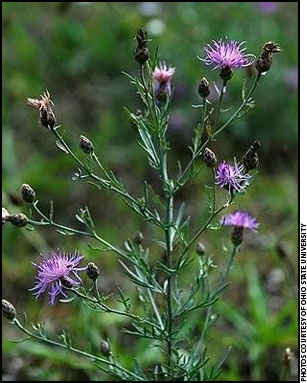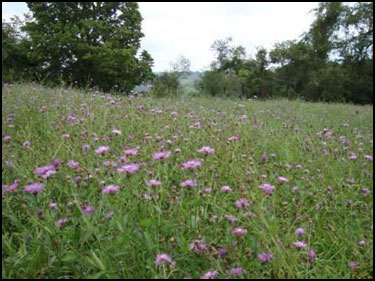Aggressive Weed a Potential Problem
for Livestock Producers
An aggressive perennial weed, common throughout the western United States, has found its way to Ohio, overtaking pastures and hay fields and creating an undesirable feeding situation for livestock.
Clif Little, an Ohio State University (OSU) Extension educator, said that dense infestations of spotted knapweed have been found in Guernsey County and pockets of the weed are extending into Muskingum, Morgan, Noble, Belmont and Monroe counties in pastureland and along roadways.
"Livestock avoid eating the plant and it crowds out more desirable grasses and legumes," said Little.
Little said that the spread of spotted knapweed is a concern because the plant is a prolific seed producer, generating as many as 1,000 seeds per plant. In addition, it's easily distributed via movement of equipment, hay hauling and mowing.
"The best knapweed control program is early detection and eradication," said Mark Loux, an OSU Extension weed specialist. "The plant, which can grow 1 to 4 feet (ft.) tall, is attractive with purple flowers resembling those of red clover."
Livestock producers are encouraged to adhere to the following recommendations to avoid spreading spotted knapweed to new areas:
• Avoid spreading this weed seed on farm machinery.
• Avoid purchase of seed containing knapweeds and utilize only certified seed when planting.
• Manage hay fields and pastures to promote dense grass growth, which will help reduce the establishment of knapweed.
• Control the plant as soon as you see it. In small areas around the house pull it up and burn it. It may also be spot-treated using a glyphosate product such as Roundup or one of the many other products containing this active ingredient.
For pasture and grass hay fields there are several broadleaf herbicide options depending on knapweed state of maturity and use of the forage. Milestone® at 5 ounces (oz.) to 7 oz. per acre or ForeFront® at 2 pint (pt.) to 2.6 pt. per acre can provide effective control. Other possible options include dicamba [1 lb.-2 lb. active ingredient (a.i.) per acre] or Curtail (4 pt.-6 pt. per acre). Treatment with 2,4-D (2 lb. a.i. per acre) can be effective when plants are in the rosette stage in fall or early spring.
 Refer to product labels for herbicide use restrictions regarding grazing, hay harvest and replanting.
Refer to product labels for herbicide use restrictions regarding grazing, hay harvest and replanting.
OSU Extension specialists urge caution when making broadleaf herbicide applications, as the chemical will injure legumes such as clover and alfalfa.






